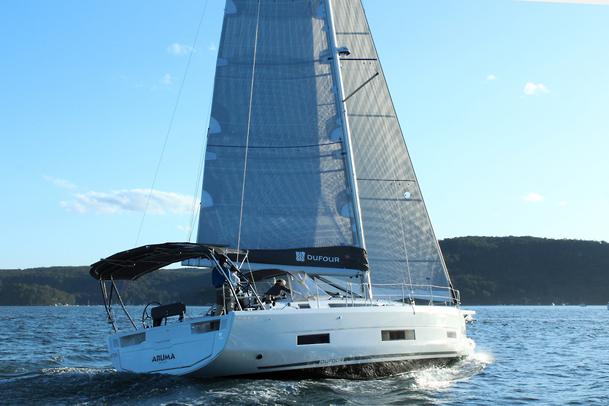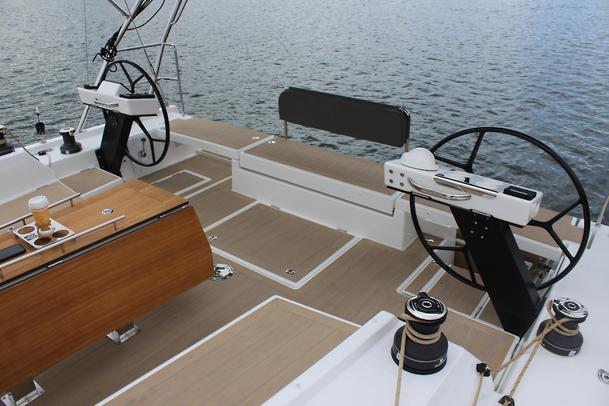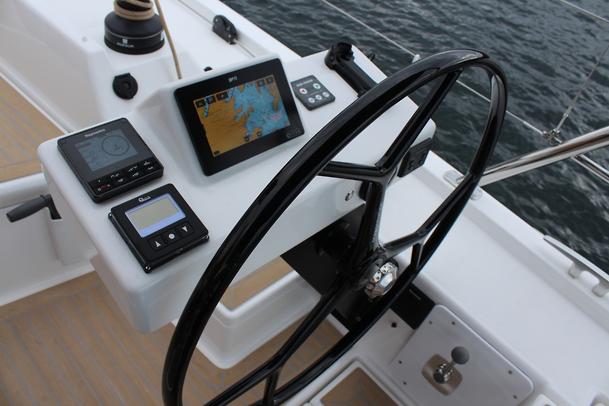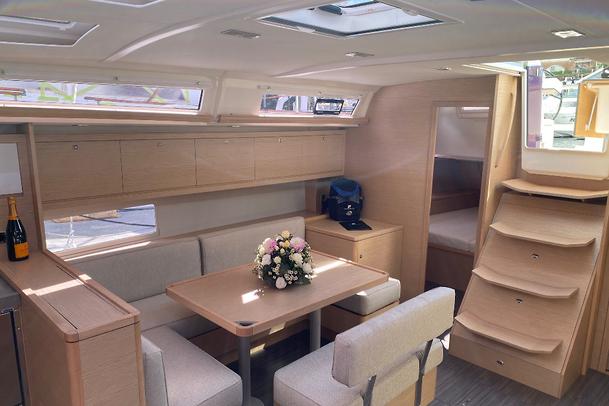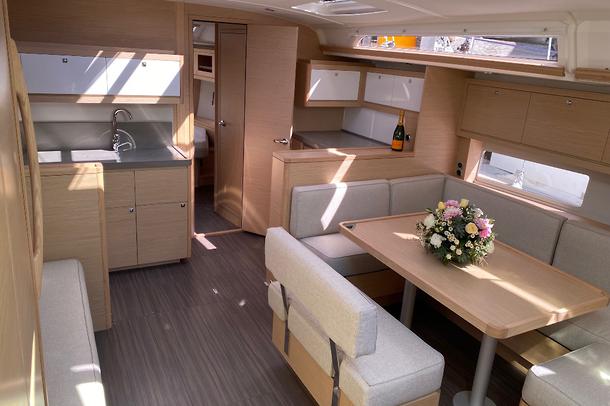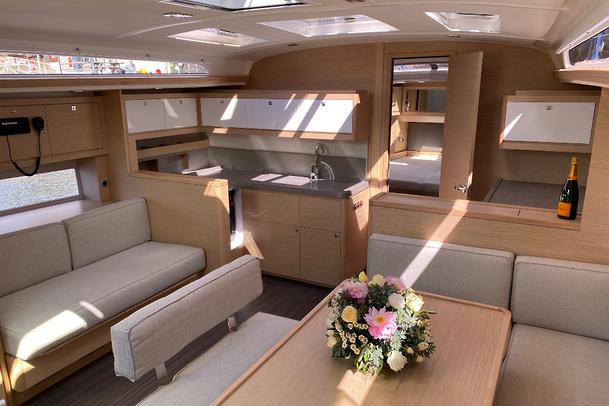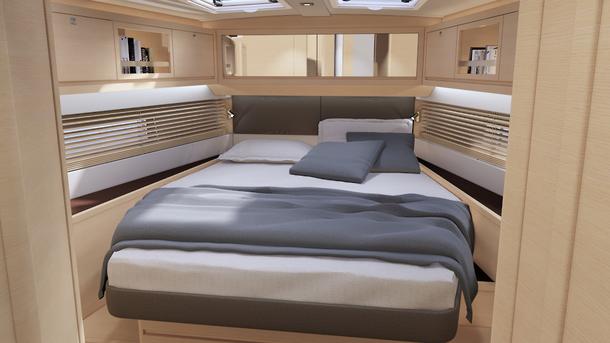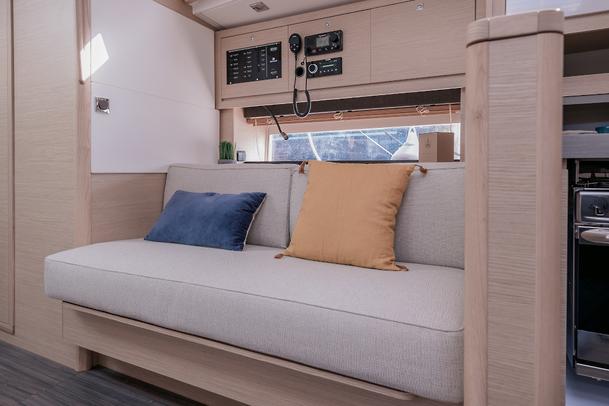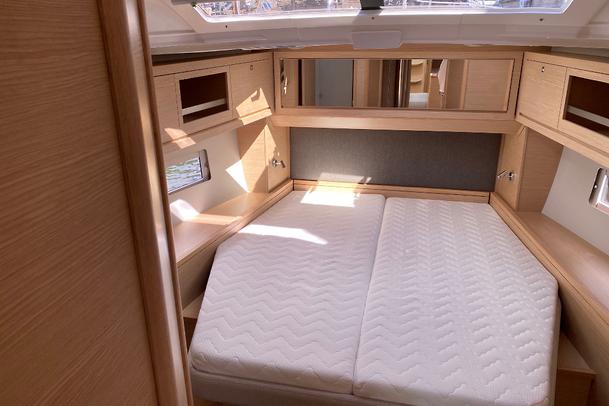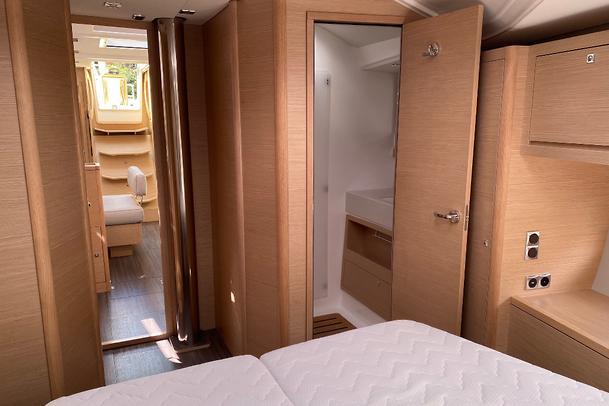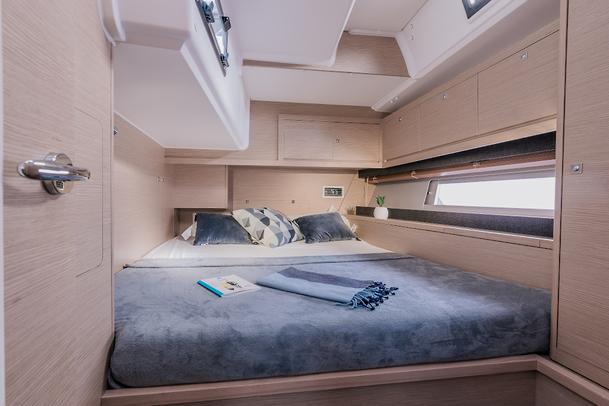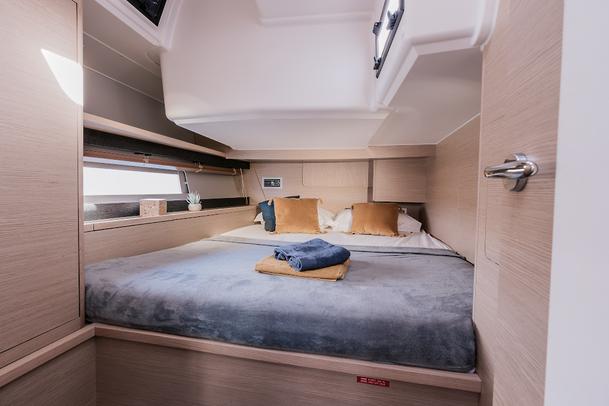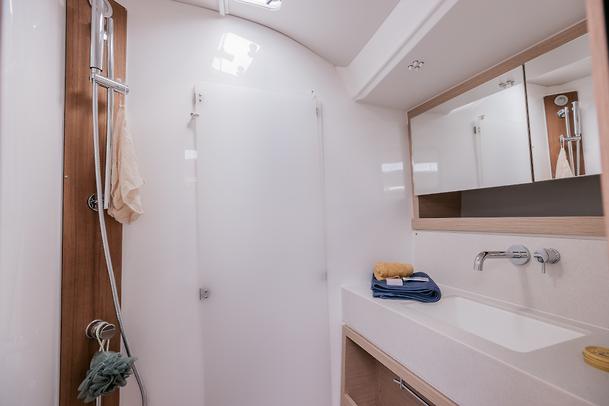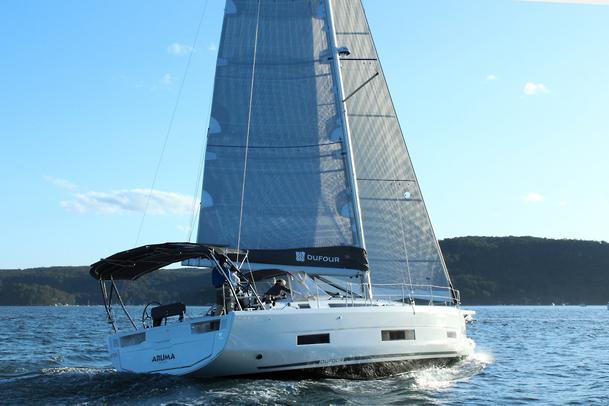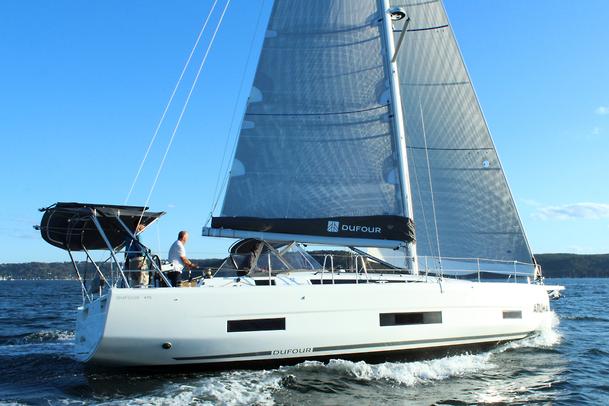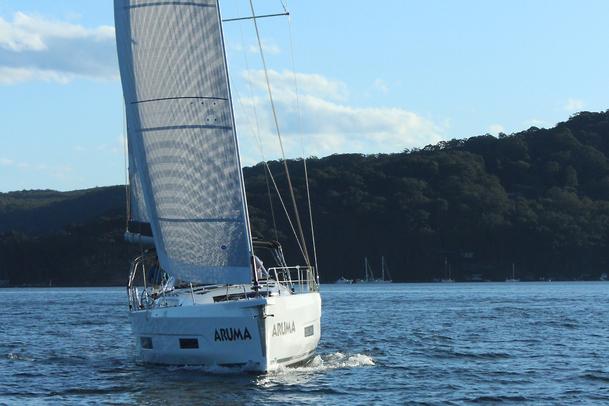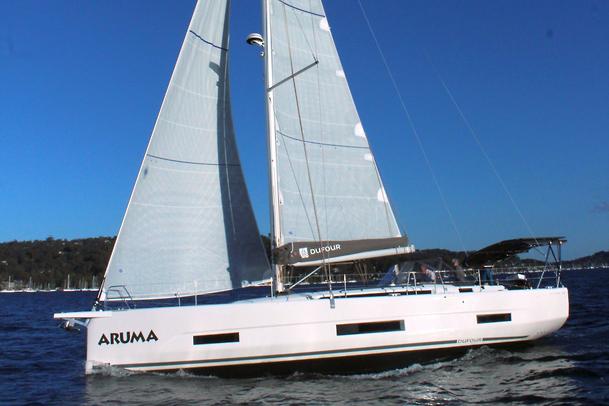The Dufour 470 is an ideal coastal cruiser with a decent turn of speed when needed. By Ocean magazine.
Few things are more enjoyable to windward than a deep-keeled monohull with a good suit of sails, such as the Dufour 470.
Overview
The Dufour 470 made its Australian debut at the 2021 Sanctuary Cove Boat Show via The Yacht Sales Co.
Dufour’s range comprises a nine-boat range in lengths from the entry-level Dufour 37 up to the Dufour 61 flagship.
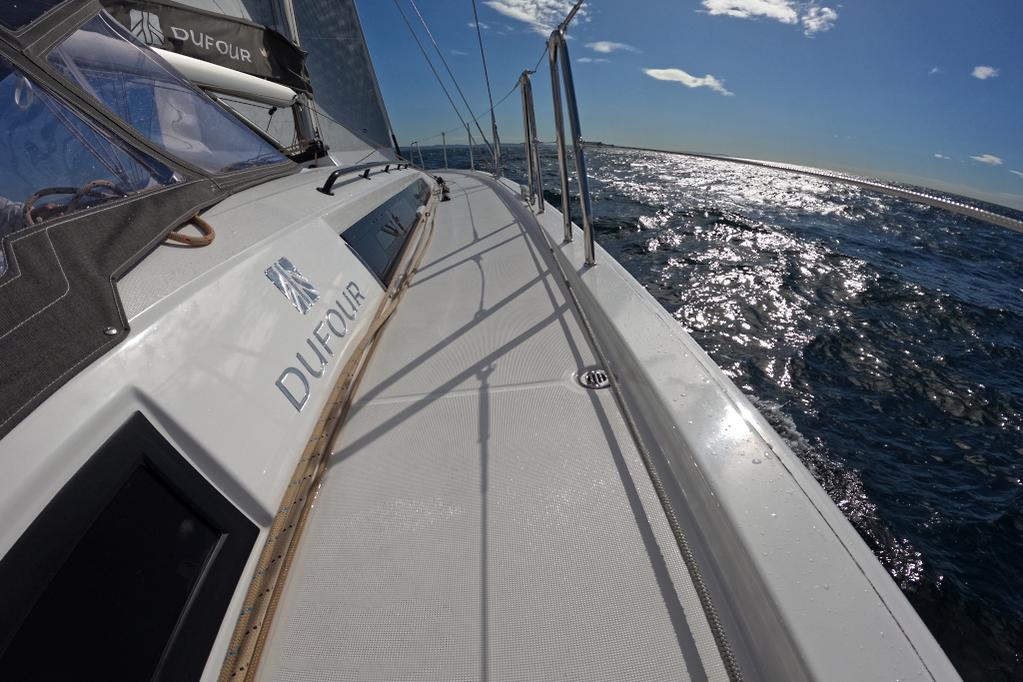
In its early days and under company founder Michele Dufour, the yard was known for performance cruisers.
Several changes of ownership later, Dufour Yachts is now owned by multihull specialist Fountaine Pajot and concentrates on general cruising yachts designed by Italian architect Umberto Felci.
Price and equipment
The Dufour 470 is available in three versions; conventionally rigged Ocean, regatta-ready Performance and shorthanded-friendly Easy.
The Easy version of the Dufour 470 includes a self-taking jib, in-mast furling and saloon top-mounted mainsheet, while the Performance version includes a deeper keel for improved windward performance, six winches and a transom-mounted mainsheet track.
The base price for the Dufour 470 Ocean, the subject of our test, starts from $724,500. It also has locally cut carbon EM2 sails by Hood that set beautifully when bent on the Z-Spars alloy mast with wire shrouds and double backstay.
Even while moored at the Middle Harbour Yacht Club in Sydney, there is plenty to enjoy about hull No.48.
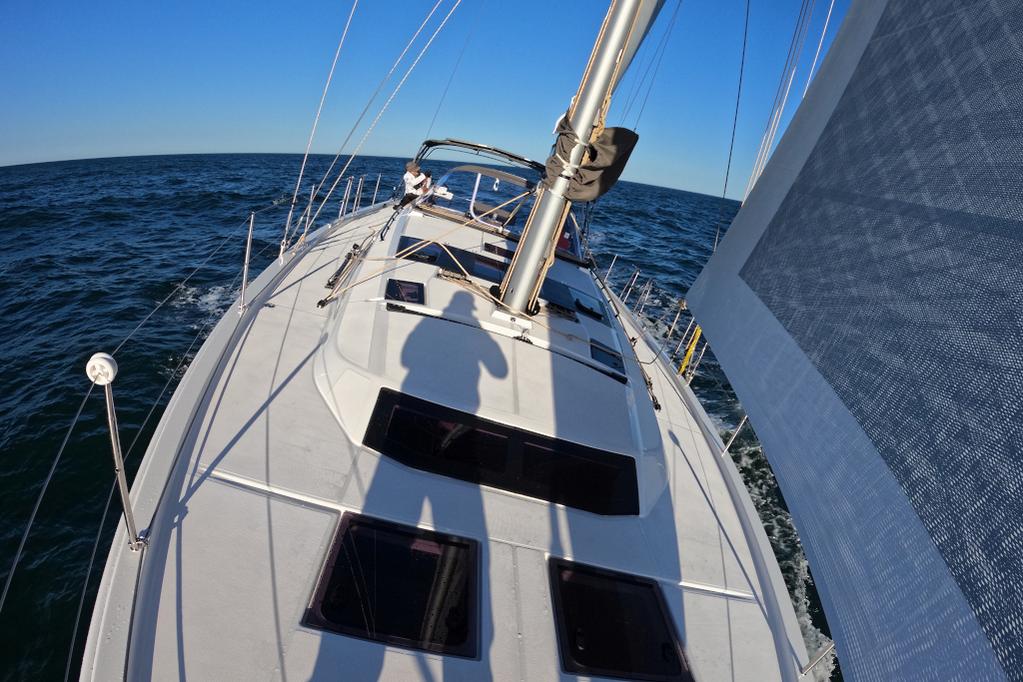
A cruising yacht’s cockpit has to be a versatile space because it must function both at sea and at rest, something the Dufour 470’s Italian designer clearly understands.
The large and wide teak-clad cockpit is divided into a central area for relaxing, and with sail controls aft and on the coachroof.
The throttle for the 75hp Volvo Penta D2 saildrive is well-placed on the starboard binnacle, as are the controls for the bow thruster that retracts when not in use to give the hull a clean profile.
The saildrive’s ignition is conveniently beside the Raymarine multifunction chartplotter, as is the engine’s tacho.
The diameters of the twin composite steering wheels are just right for standing or heeled and sitting outboard with the foot plates deployed.
Good features abound elsewhere in the cockpit, such as ample space to walk between the twin binnacles, and easy access to the rudder shaft to fit the supplied tiller that serves as emergency steering.
At sea, the elongated cockpit table has wide fold-out teak wings and a larger Raymarine screen that’s visible to the cockpit.
The table also serves as a useful brace, and can come fitted with a fridge and storage.
Our review boat was offshore-ready with a spray hood and bimini fitted with 1200 watts of solar panels, and a hinged swim platform.
Of note, the main hatch providing access to duck below uses fashionable saloon-style doors rather than my preferred sliding washboards, but that is really the only blemish in the Dufour 470’s cockpit.
Hull and engineering
Strong aesthetics characterised by upright hulls with high-volume interiors and low-profile deck saloons are a feature of all Felci-designed Dufours.
The Dufour 470’s vast 4.7-metre beam carries to the transom to further maximise volume, increase form stability and create a planing area for gaining downwind speed. Hard chines give linear stability.
A major upside of the wide hull is a lack of major heeling angle, something that improves life aboard under sail.
Engine access is via a lifting companionway. It opens to a conventionally laid-out engine room with access to all service points on the Volvo Penta diesel saildrive.
The resin-infused, foam-cored vinylester hull has a long, hard chine aft and deep forward sections with a contemporary snub bow and vertical transom that maximises the 13.6-metre waterline.
The deck is made from injection-moulded foam that provides insulation and weight savings.
The Dufour 470 uses a single deep spade rudder on a stainless shaft.
Ballast is provided by an L-shaped cast iron keel that won’t snag when coastal cruising – something the Dufour 470 looks eminently suited for.
The ballast ratio is modest at only 26.9 per cent, but similar to many modern designs, stability comes from the wide beam and big volume.
A sail area displacement (SAD) ratio of 19.5 slots the Dufour 470 in the moderate weighted cruiser class.
Layout and accommodation
The saloon’s open-plan arrangement is the modern finish at which European yachts excel.
The Dufour 470’s saloon is intended to suit both offshore and anchorage, but there are compromises.
This includes a lack of handholds, with my preference for one mounted longitudinally on the roof to help with forward access while underway.
There is a spacious dinette lounge with surrounding seating for about eight, as well as a bench seat on the port side with sumptuous cushioning.
The Dufour 470 can have its galley forward, as on our test boat, but it also can be located longitudinally amidships.
The Dufour 470 is a very good example of this. The galley space is surrounded with overhead lockers and features a double fridge-freezer and lots of worktop area with enough real estate for two crew to prepare food.
Traditionalists may baulk at this large yacht feature, but it frees up the entire aft saloon for entertainment, as well as a corner chart bench where some electronics could be housed on the bulkhead.
One of the options for accommodations is the large V-berth and two double berths aft built into hull No.48.
Another layout for this high-volume hull is for four cabins, each with an ensuite, which makes it ideal for the charter market.
Alternatively, dedicated cruising sailors may choose a three-cabin, two-head version.
The aft berths are the most comfortable at sea, but the trend towards European-style stern-to mooring favours the large forward V-berth, to give owners more privacy.
The queen-size bed on our test boat has access on both sides, and storage beneath.
The tall topsides mean headroom in this space is generous, and there is plenty of extra space for lockers and shelves.
Ventilation and natural light is also superb with the space using a rectangular forward-facing skylight.
Also good is the split shower and head located on separate sides of the V-berth.
Looking aft, despite being under the cockpit floor the two symmetrical double cabins retain good volume and have easy access to the shared second bathroom.
Again, locker space is generous, as is the natural light from the elongated portlights. In fact, natural light is a notable feature throughout the Dufour 470’s interior, with the sense of light enhanced via light timber finishes.
On the water
The retractable Side-Power thruster easily pushed the tall topsides against the breeze to help us cast off from the marina.
At the wheel was new owner Tom, his wife Janice as crew, and our host for the day, The Yacht Co sales and business development manager Bob Vinks.
Once clear and motoring away, the 75hp Volvo Penta D2 saildrive showed its mettle, pushing us along at 7.0 knots at 2500rpm, with no vibration from the folding propeller.
The Lewmar electric winch and lazyjacks made short work of hoisting the Hood mainsail once we pointed into the wind, and with the genoa set – it uses a tape furler that is smoother than a drum furler – we surged off towards Sydney Heads for our coastal passage north to Pittwater.
Few Sydney boaters venture beyond the Heads, with many happy to just sail in Sydney Harbour’s enclosed waters.
For the more adventurous among us, the first test is the confused, surging southerly swell that marks the entrance and acts as a reminder to batten all hatches, close doors and stow gear.
There was no structural groans from the Dufour 470 , a sign of the strength and rigidity afforded by the glassed-in bulkheads and solidly laid-up hull.
There was the inevitable crash landing and spray over the foredeck as the 1.5-metre swell met our blunt bow, but the deep cockpit and sprayhood offered good protection.
The generous amount of space around the jib sheet winches and the German mainsheet made setting up for a tack easy, via controls on both sides a mainsheet track on the cabin top.
Tacking through about 100 degrees, we made our way north, punching against wind and tide. Despite these conditions, the predictable roll of the 470 allowed us all to settle into a rhythm for an enjoyable experience.
Sitting on the gunwale and bracad on the lifting footplate, the helm can easily reduce pressure on the deep spade rudder via judicious use of the sheets.
With an easy grip on the composite wheel and a clear view of the telltales on both genoa and mainsail, it was a very enjoyable experience.
Tom, the Dufour 470’s owner, had managed about 7.0 knots approaching Long Nose Point, the midway point to our destination
That was the benchmark to beat. Despite the sometimes fickle breeze, and with flatter water than Tom had before he handed over the wheel, I reached 8.9 knots hard on the breeze at 42 degrees, and with 19 knots of true wind.
That’s impressive, and in a large part due to the excellent Hood EM2 sails.
As I said earlier, few things are more enjoyable to windward than a deep-keeled monohull. The refinement of this Dufour 470 adds to that.
Verdict
Sailboats are built for a purpose and need to be judged accordingly. Dufour 470, hull No.48, aims to be a general cruising yacht. It eminently succeeds at this.
Given that Hamilton Island Race Week, Australia’s premium sailboat regatta, is now largely made up of these ‘œcompromised cruiser’-style yachts, this Dufour 470 should yield plenty of enjoyment on the race course, but still pamper you once you return to base to claim the handicap trophy.
Specifications
Model: Dufour 470 Ocean
Length overall: 14.85m
Waterline length: 13.55m
Beam: 4.74m
Draft: 2.25m
Displacement: 13,200kg (light)
Ballast: 3550kg
Sail area displacement ratio: 19.5
Sails: mainsail 57.0m²/genoa 50m²/asymmetric or Code O
Engine: 60hp Volvo Penta D2 saildrive (std)/75hp Volvo Penta D2 saildrive (opt)
Fuel: 250L
Water: 530L
Accommodation: 3 cabins/6 people
